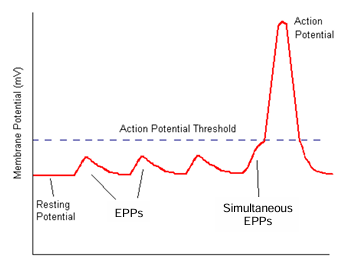neurotransmission and the neuromuscular junction
1/18
There's no tags or description
Looks like no tags are added yet.
Name | Mastery | Learn | Test | Matching | Spaced |
|---|
No study sessions yet.
19 Terms
electrochemical neurotransmission
conversion of electrical signal to chemical signal at the synapse
synaptic neurotransmission - electrochemical coupling at the synapse
action potential reaches and depolarises axon terminal
depolarisation activates voltage gated, pre synaptic Ca2+ channels
localised calcium entry triggers fusion of synaptic vesicles to membrane, and exocytosis of neurotransmitters (NTs) from vesicles into the synaptic cleft
NTs diffuse into synaptic cleft
NTs bind to active receptors on the post synaptic membrane, eliciting response
NTs are inactivated

neurotransmitters
small rapid acting messengers
generally, neurons release one type of major NT
acetylcholine, glutamate - generally considered to be excitatory
GABA, glycine, serotonin - generally considered to be inhibitory
noradrenaline
each NT has specific receptors
neurons may express receptors for multiple NTs
neurotransmitter lifecycle
precursor uptake e.g. amino acid
NT synthesis
NT uptake into vesicles
NT release into synaptic cleft
receptor binding - post synaptic and pre synaptic cell
inactivation of NT
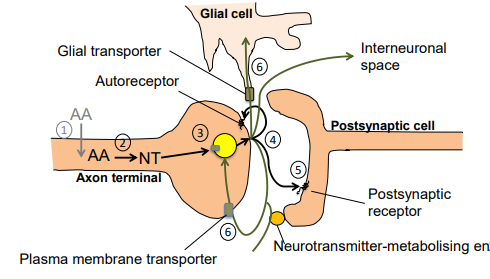
ionotropic receptors
ligsnd gated ion channels
NT binding opens the channels; ion flow through
involved in fast synaptic transmission
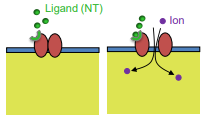
metabotropic receptors
also known as G protein coupled receptors (GPCR)
NT binding activated G-protein that either modifies function of ion channels or triggers intracellular signalling
involved in slower synaptic transmission
mediated short term as well as long term effects (e.g. gene expression)

neurotransmitter inactivation mechanisms
inactivated/degraded by enzymes in the synaptic cleft
taken up by presynaptic neuron via transporter protein
taken up by glial cell
diffuses away into periphery

neurotransmitter examples
acetylcholine
dopamine (DA)
noradrenaline (NA)
adrenaline (A)
serotonin (5-HT)
histamine
glutamate (L-Glu)
y-amino-butyric acid (GABA)
glycine (L-Gly)
glutamate
major excitatory neurotransmitter in the brain
essential neurotransmitter in synaptic plasticity, learning and memory, and higher processing
excessive glutamate signalling can cause excitotoxicity
inactivation - removed from the synaptic cleft primarily by astrocytes that express glutamate transporters

glutamate receptors
four glutamatergic ionotropic receptors (GIuR)
N-methyl-D-aspartate (NMDA) receptors
AMPA
kainate
delta
eight glutamatergic metabotropic receptors
mGluR1-8
glutamate excitatory NT
the NT as an excitatory synapse depolarizes the post synaptic membrane e.g. glutamate and NMDA receptor
GABA
major inhibitory neurotransmitter in the CNS - counterbalances action of glutamate
two types:
GABAA: ionotropic, ion channels are permeable to Cl-
GABAB: metabotropic
inactication: reuptake into pre-synaptic neuron (or astrocytes) by GABA transporters (GAT)
GABA inhibitory NT
the NT at an inhibitory synapse hyperpolarizes the post-synaptic membrane e.g. GABA and GABAA receptor
Acetylcholine
major CNS NT for consciousness (arousal), learning and memory
In the PNS
regulates all motor transmission at the neuromuscular junction
regulates autonomic nervous system
inactivate by acetylcholinesterase (AChE)
botulinum toxin (Botox) blocks the release of acetylcholine from pre synaptic neurons
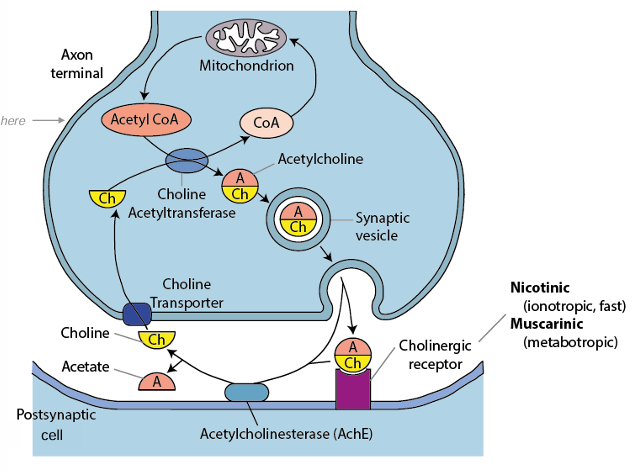
cholinergic receptors
receptors activated by binding of acetylcholine
nicotinic (nAChR) cholinergic receptors
also activated by nicotine
ionotropic (fast responses)
ion channels are permeable to Na+, Ca2+ , K+
excitatory
NM type at the skeletal neuromuscular junction
NN type on all postganglionic ANS cell bodies

muscarinic (mAChR) cholinergic receptors
also activated by mushroom poison muscarine
G protein-coupled metabotropic receptors - slower acting effects
5 types (M1-M5)
most cholinergic pathways in the CNA involve muscarinic receptors
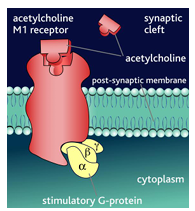
neuromuscular junction
action potential propagates along the motor neuron to axon terminal
local calcium influx (voltage gated Ca2+ channels) triggers release of the neurotransmitter ACh into the synapse
ACh diffuses across synaptic cleft and binds to nicotinic ACh receptors on the motor end plate (muscle fiber)
ACh binding triggers opening of ligand gated ion channels. Na enters muscle fiber (small efflux of potassium) = end plate potential
if the threshold of -50mV reached → action potential is initiated and propagates across muscle fiber → muscle contraction
ACh is degraded in the synaptic cleft of Acetylcholinesterase

end plate potential
An EPP partially depolarizes the the muscle membrane
multiple/ simultaneous EPPs i.e. release of multiple ACh vesicles, are required to push the muscle above the action potential threshold and generate an action potential
